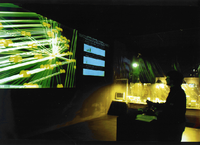Einleitung
Eine Definition was genau Physical Computing ist, gibt es nicht. Verschiedene Betrachtungsweisen und intuitive Interpretation bedeuted im physische Prozesse im Computer abzubilden. Dabei kann von der Interaktion ausgegangen werden wie es von Mark Sullivan vorgeschlagen wird:
"Physical Computing is an approach to computer-human interaction design that starts by considering how humans express themselves physically. Computer interface design instruction often takes the computer hardware for given — namely, that there is a keyboard, a screen, speakers, and a mouse or trackpad or touchscreen — and concentrates on teaching the software necessary to design within those boundaries. In physical computing, we take the human body and its capabilities as the starting point, and attempt to design interfaces, both software and hardware, that can sense and respond to what humans can physically do. [Sullivan, New York University]
Hier wird der Begriff eher verwendet um eben die Schnittstelle zwischen physischer Welt und Computer definieren, bei die Interaktion mit Menschen nur ein Teil ist. Als Schnittstellen des Computer zur physischen Welt werden allgemein Aktoren und Sensoren verwendet. Heutzutage, wo die virtuelle Welt zunehmend als Erweiterung der Realen Welt erscheint, das Konzept des Cyperspace we es in der SF [Lem 64, Gibson 84] vorhergesagt wurde, ist auch die Schnittstelle zu virtuellen Welten wichtig wo es Datenströme rein und raus gibt, also Netzwerk und deren Schnittstellen.
Das bedeutet Sensoren fühlen und Aktoren steuern die physische Welt, Netzwerke verbinden Virtuelle Welten mit dem Computer, welcher diese Daten prozessiert.
Das kann im Bereich der Audiotechnik und Computermusik unter anderem mittels "embedded computer" umgesetzt werden. Anhand solch eines computer mit spezieller hard- und software können Instrumente, Effekte und anderes mehr kreiert werden. Diese Vorlesung and später Übung soll die notwendigen Grundlagen, Systeme, Schnittstellen erklären: von grafischer Programmierung hin zur Treiberentwicklung und Interfacing.
---
Physical computing, in its broadest sense, means creating interactive, physical systems through the use of hardware and software. These systems respond to and/or act upon events in the real, analog world.
There is no common definition of what exactly physical computing is. Different ways of looking at it and intuitive interpretation means to represent physical processes in a computer. Thereby it can be started from the interaction as it is suggested by Mark Sullivan:
"Physical Computing is an approach to computer-human interaction design that starts by considering how humans express themselves physically. Computer interface design instruction often takes the computer hardware for given - namely, that there is a keyboard, a screen, speakers, and a mouse or trackpad or touchscreen - and concentrates on teaching the software necessary to design within those boundaries. In physical computing, we take the human body and its capabilities as the starting point, and attempt to design interfaces, both software and hardware, that can sense and respond to what humans can physically do. [Sullivan, New York University]
Here the term is rather used to define the interface between the physical world and the computer, where interaction with humans is only one part. Actuators and sensors are commonly used as interfaces of the computer to the physical world. Nowadays, when the virtual world increasingly appears as an extension of the real world, the concept of cyperspace as it was predicted in SF [Lem 64, Gibson 84], the interface to virtual worlds is also important where there are data streams in and out, i.e. network and its interfaces.
This means sensors feel and actuators control the physical world, networks connect virtual worlds to the computer which processes this data.
This can be implemented in the field of audio technology and computer music, among other things, by means of "embedded computers". Using such a computer with special hard- and software, instruments, effects and more can be created. This lecture and later exercise will explain the necessary basics, systems, interfaces: from graphical programming to driver development and interfacing.

